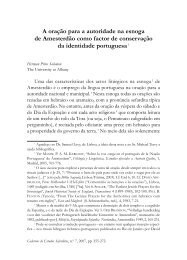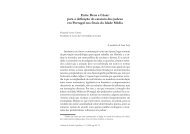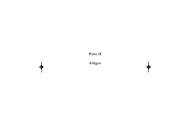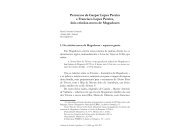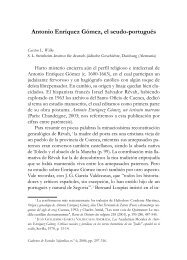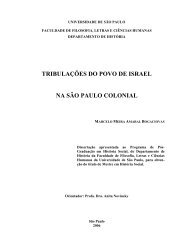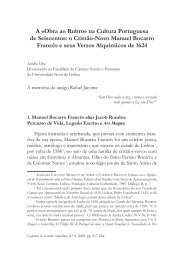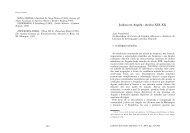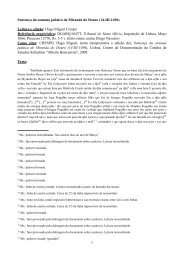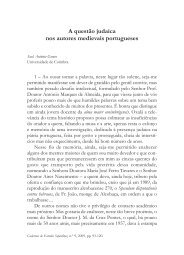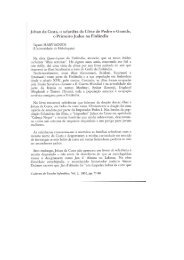Pagina 1-28.qxd - Cátedra de Estudos Sefarditas "Alberto Benveniste"
Pagina 1-28.qxd - Cátedra de Estudos Sefarditas "Alberto Benveniste"
Pagina 1-28.qxd - Cátedra de Estudos Sefarditas "Alberto Benveniste"
You also want an ePaper? Increase the reach of your titles
YUMPU automatically turns print PDFs into web optimized ePapers that Google loves.
Pag 33-62:<strong>Pagina</strong> 1-<strong>28.qxd</strong> 10-12-2009 01:13 Page 57<br />
KIng ManUel I anD tHe exPUlSIOn OF tHe CaStIlIan ConvERSoS anD MUSlIMS...<br />
Por tuguese sovereign the bull Ineffabilis et Summi. this bull was an<br />
almost i<strong>de</strong>ntical copy of the one granted only two years previously,<br />
with exactly the same name, to Isabel and Fernando. the Pope<br />
<strong>de</strong>creed that the Portuguese monarch and all his <strong>de</strong>scendants could<br />
possess in perpetuity any lands conquered from the infi<strong>de</strong>ls. the<br />
only major disparity between this version of Ineffabilis et Summi and<br />
the one granted to Isabel and Fernando was that it explicitly cautioned<br />
other Christian princes not to molest, impe<strong>de</strong> or wage war<br />
against Manuel I and his <strong>de</strong>scendants. the Portuguese sovereign<br />
was likewise instructed by the Pope not to impinge upon the territories<br />
of other Christian rulers. the version of Ineffabilis et Summi<br />
granted to King Manuel mentioned the fact that, by means of his<br />
ambassadors, the king of Portugal had conveyed to the pope his<br />
“intention to fight the infi<strong>de</strong>ls in the manner of his forbearers”. 49<br />
as the mo<strong>de</strong>rn historian Charles Martial <strong>de</strong> Witte has pointed out,<br />
the lands to which Ineffabilis et Summi referred were clearly those of<br />
north africa rather than any other future territorial conquests that<br />
might result from the naval expedition to India which was also been<br />
concurrently planned by Manuel. 50 the Pope was, of course, an -<br />
xious not to affront the rulers of Castile and aragón and thus<br />
chose to remain <strong>de</strong>liberately vague in the terms and expressions<br />
used in the bull. this vagueness was not a new <strong>de</strong>velopment in the<br />
diplomacy of the Papal Curia and had been already employed by<br />
Pope alexan<strong>de</strong>r in 1493-4 to preserve the balance of power and<br />
peace between both Iberian realms. 51 From Manuel’s point of view,<br />
49 “...et ad se<strong>de</strong>m ipsam successu temporis conuerti sane pro parte tua nobis nuper per venerabilem<br />
fratrem nostrum Georgium Episcopum Albanensem sanctae Romae ecclesie Cardinalem vlixbonensem<br />
nuncupatur expositum sint quod tu qui more tuorum progenitorum intendis Infi<strong>de</strong>lium expugnationi<br />
vacare <strong>de</strong>si<strong>de</strong>ras...» J. MaRtInS Da SIlVa MaRQUeS, Descobrimentos portugueses. Documentos para<br />
sua história (lisbon, 1944), Vol. 3, 479-480, doc. 315.<br />
50 CH-M. De WItte, ‘les bulles pontificales et l’expansion Portugaise au xVe siècle’,<br />
Revue d’Histoire Ecclésiastique, 53 (1958), 452-3.<br />
51 H. VanDeR lInDen, ‘alexan<strong>de</strong>r VI, and the <strong>de</strong>marcation of the maritime and colonial<br />
domains of Spain and Portugal, 1493-1494’, The American Historical Review, 22 (1916), 1-20.<br />
57



